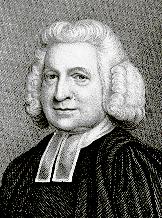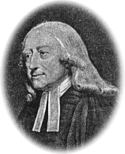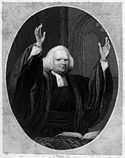Charles Wesley
|
||||||||||||||||||
|
||||||||||||||||||
Charles Wesley (18 December 1707 – 29 March 1788) was a leader of the Methodist movement, the younger brother of John Wesley. Despite their closeness, Charles and his brother did not always agree on questions relating to their beliefs. In particular, Charles was strongly opposed to the idea of a breach with the Church of England into which they had been ordained. Charles Wesley is chiefly remembered for the many hymns he wrote. He founded Wesley Chapel in the village of Brayton, which is just south of Selby. His house, located nearby, can still be visited today.
Contents |
Biography
Charles Wesley was the son of Susanna Wesley and Samuel Wesley. Like his brother John, Charles Wesley was born in Epworth, Lincolnshire, England, where their father was rector. He was educated at Westminster School and Christ Church, Oxford, where his brother had also studied, and formed the "Oxford Methodist" group among his fellow students in 1727 which his elder brother, John joined in 1729 soon becoming its leader and moulding it to his own notions. George Whitefield also joined this group. After graduating with a Masters' in classical languages and literature, Charles followed his father and brother into the church in 1735, and travelled with John to the colony of Georgia in America in the entourage of the governor, James Oglethorpe, returning a year later.
Charles lived and worked in the area around St Marylebone Parish Church and so, just before his death, he sent for its rector John Harley and told him "Sir, whatever the world may say of me, I have lived, and I die, a member of the Church of England. I pray you to bury me in your churchyard." On his death, his body was carried to the church by eight clergymen of the Church of England and a memorial stone to him stands in the gardens in Marylebone High Street, close to his burial spot. One of his sons, Samuel, was later organist of the present church.[1]
Marriage and children
In 1749, he married the much younger Sarah Gwynne, daughter of Marmaduke Gwynne, a wealthy Welsh magistrate who had been converted to Methodism by Howell Harris. She accompanied the brothers on their evangelistic journeys throughout Britain, until Charles ceased to travel in 1765.
Charles and Sarah had 8 children together. However only three of them survived infancy, Charles Wesley junior (1757-1834), Samuel Wesley (1766 – 1837), and their sister Sarah Wesley. Both Samuel and Charles junior were organists and composers; Samuel Wesley's son, Samuel Sebastian Wesley was one of the foremost British composers of the 19th century, and some of Charles junior's works are still available and played.
Best-known hymns
In the course of his career, Charles Wesley published the words of over five and a half thousand hymns, writing the words for a further two thousand, many of which are still popular. These include:
- "And Can It Be That I Should Gain?" (Lyrics)
- "Christ the Lord Is Risen Today" (Lyrics)
- "Christ, Whose Glory Fills the Skies" (Lyrics)
- "Come, O Thou Traveler unknown" (Lyrics)
- "Come, Thou Long-Expected Jesus" (Lyrics)
- "Hail the Day that Sees Him Rise" (Lyrics)
- "Hark! the Herald Angels Sing" (Lyrics)
- "Jesus, Lover of My Soul" (Lyrics)
- "Jesus, The Name High Over All" (Lyrics)
- "Lo! He Comes with Clouds Descending" (Lyrics)
- "Love Divine, All Loves Excelling" (Lyrics)
- "O for a Thousand Tongues to Sing" (Lyrics)
- "Rejoice, the Lord is King" (Lyrics)
- "Soldiers of Christ, Arise" (Lyrics)
- "Ye Servants of God" (Lyrics)
The lyrics to many more of Charles Wesley's hymns can be found on Wikisource.
Some 150 of his hymns are included in the Methodist hymn book Hymns and Psalms.
Legacy
He is commemorated in the Calendar of Saints of the Evangelical Lutheran Church in America on March 2 with his brother John.
As a result of his enduring hymnody, the Gospel Music Association recognized his musical contributions to the art of gospel music in 1995 by listing his name in the Gospel Music Hall of Fame.
Tercentenary
On 24th May 2007, there was a tercentenary celebration to celebrate 300 years since the birth of Charles Wesley, and many celebrations were held throughout England. It was held on the 24th May, known to all Methodists as 'Wesley Day,' although Charles Wesley was not born until December 1707. The May date actually commemorates the spiritual awakening of first Charles and then John Wesley in 1738. In particular, in the Village of Epworth, North Lincolnshire, at the Wesley Memorial Methodist Church, there was a fantastic flower festival, on the 26th 27th and 28th May, with some of the most astounding flower arrangements, representing some of Charles Wesley’s hymns, from ‘O for a Thousand Tongues to Sing,’ to ‘And Can It Be,’ and not forgetting ‘O For a Trumpet Voice,’ the name of the flower festival.
In November 2007, An Post, the Irish Post Office issued a 78c stamp to commemorate the 300th Anniversary of his birth.
References
- Abbey, Charles J. (1892) Religious thought in old English verse, London : Sampson Low, Marston, 456p., ISBN (?) 0-7905-4361-3
- Tyson, John R. (Ed.) (2000) Charles Wesley : a reader, Oxford : Oxford University Press, 519 p., ISBN 0-19-513485-0
- Tyson, John R. Assist Me to Proclaim: The Life and Hymns of Charles Wesley. Grand Rapids: Wm. B. Eerdmans and Göttingen: Edition Ruprecht 2007, ISBN 978-3-7675-3052-2 DOI 10.2364/3320751449
External links
- Charles Wesley Hymn Festivals for 2007, Sermons from Goettingen [www.online-sermons.info]
- Free scores with lyrics by Charles Wesley in the Choral Public Domain Library (ChoralWiki)
- Free scores by Charles Wesley in the Werner Icking Music Archive (WIMA)
- Hymns by Charles Wesley
- The Journal of Charles Wesley
- Charles Wesley Conference 2007 held at Liverpool Hope University
- 'Charles Wesley in Historical Perspective: Poet, Priest and Theologian', lecture delivered by Revd Professor Kenneth Newport, at Gresham College, 13th December 2007. (Available for download as MP3 and MP4).
- Charles Wesley's Journeys on Vision of Britain


